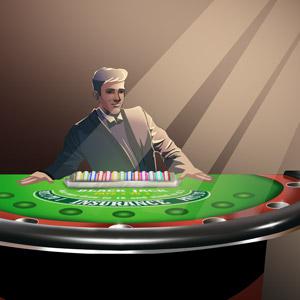In any game of blackjack, your sole objective is to beat the dealer. This is the same for blackjack online and in land-based casinos around the U.S., Europe, Asia, and any other country. Despite all variations of blackjack sharing the same goal, the games offered in land-based casinos abroad do somewhat differentiate from the traditional games played in the U.S. This article summarizes what those key differences are in variations of blackjack around the world.
The No-Hole-Card Rule in the US

When you play blackjack in the U.S., the no-hole-card rule dictates that the dealer cannot reveal their second card until all the other players have acted on their hands. Many gamblers mistakenly assume this gives the house a bigger advantage because the odds of the dealer busting their hand are lower when the cards are dealt consecutively. Statistically, the odds don’t change whether the dealer does or doesn’t take their second card after all of the other players have completed their hands.
The No-Hole-Card Rule in Europe
What does impact your playing strategy and the odds in no-hole-card games is when a player loses to splitting and doubling down on their hand when the dealer’s second card gives him/her a blackjack. This is a very possible scenario with the European no hole card rule. It increases the house edge by approximately 0.11% depending on the specific rule.
The following reveals the strategic moves you can take using the European no hole card rule in a multi-deck game. For example, when the dealer hits soft 17 and you can double after splitting a pair. Also, how they compare with the same moves in an American game. The strategy would change according to when the dealer reveals a 10 or Ace, and the game is subject to:
- Hitting a hard 11 against a dealer’s 10
- Hitting a pair of Aces against the dealer’s Ace
- Hitting a pair of eights against a dealer’s 10 and Ace
AMERICAN RULES
| Dealer’s Face-Up Card/Player Hand | 10 | Ace |
| Hard 11 | Double | Hit |
| Ace and Ace | Split | Split |
| 8 and 8 | Split | Split |
EUROPEAN NO HOLE CARD
| Dealer’s Face-Up Card/Player Hand | 10 | Ace |
| Hard 11 | Hit | Hit |
| Ace and Ace | Split | Hit |
| 8 and 8 | Hit | Hit |
Please note that the strategy for the European rule in blackjack is based on there being no surrender option in the game.
For those who may not know what surrender means: once you’ve compared your first two cards against the dealer’s up-card, you can choose to forfeit half of your wager if your hand is weak to begin with. This means you won’t finish the round empty-handed. The option is much rarer in online games of blackjack. But most brick-and-mortar casinos require you to verbally alert the other players and the dealer if you want to surrender. There are two different types of surrender in blackjack:
Late Surrender
A late surrender gives you the opportunity to surrender your hand if the dealer’s face-up card is an Ace or a ten. But this happens only after the dealer has already checked their hole card to determine if they have blackjack. If the dealer does have blackjack, the surrender option is voided and you lose your entire bet. Unless of course, you too have a blackjack.
In most U.S. casinos playing multi-deck blackjack, the two strategic rules below apply to a late surrender when the dealer stands on soft 17:
- Surrender hard 16 (not soft; 8-8) against a dealer’s 9, 10, or Ace face-up card.
- Surrender hard 15 (only 8-7 if using 8+ decks) against the dealer’s 10 face-up card.
When used correctly, a late surrender will bring the house edge down by about 0.07% in multi-deck blackjack games. It may not seem like a lot on the surface, but any reduction in the house edge is advantageous, even if it’s just a little bit.
Early Surrender
Now, early surrender is what you’d expect and it’s an option that’s more common in casinos outside of the U.S., namely in Europe and Asia. As mentioned earlier, dealers do not reveal a hole card until all players have completed their hands in these blackjack games. Hence the “European no-hole-card” rule.
An early surrender gives the player the option to surrender their hand to a dealer’s Ace card or ten-value up-card before the dealer has checked to see if their hand has a blackjack. The early surrender option is usually more favorable for players than the late surrender rule. The player gains an edge of 0.39% in games played with six decks where the dealer has an Ace and 24% if the face-up card is a ten.
In European multi-deck blackjack games, the basic strategy for playing an early surrender is slightly different from the late surrender strategy. You should surrender the following hands if early surrender is an option:
- Surrender hard 5, 6, and 7 (as well as 3s), and 12 to 17 (including 6s, 7s, and 8s) against a dealer’s Ace.
- Surrender hard 14, 15, and 16, including 7s and 8s against a dealer’s ten.
- Surrender hard 10-6 and 9-7 (not 8s) against a dealer’s 9.
It’s worth knowing that you can only surrender against a dealer’s ten face-up card in most European and Asian casinos. Aces is not an option.
In addition to what surrender can do to reduce the house edge, if you’re a math whizz and have ever tried counting cards — the surrender option is definitely worth adopting into your strategy. It can be a great stabilizer for your bankroll and help you rebalance your losses if you know you’ve got no chance against the dealer’s hold card.
The Takeaway
Hole cards and the option to surrender are the two rules that differentiate most blackjack games around the world. Every individual one of them, however, is still immensely fun to play. They also give gamblers an easy and practical way to win some cash without overly complex rules or gameplay.
Compared to games where the option isn’t offered, playing blackjack with surrender is the best way to prevent too many fluctuations in your bankroll. If you plan to play blackjack in casinos abroad, definitely try these rules out for yourself and see if your luck changes!
If you want to learn more about blackjack and start winning big you should check out our comprehensive guide 3 Basic Blackjack Strategies You Should Always Keep in Mind.




